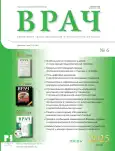Редкие хромосомные заболевания: клинический случай синдрома Лежена
- Авторы: Куценко В.П.1, Оносовская А.Н.1, Ковалева Д.Д.2, Потапова И.В.3, Волга Н.Б.3
-
Учреждения:
- Санкт-Петербургский государственный педиатрический медицинский университет Минздрава России
- Национальный медицинский исследовательский центр им. В.А. Алмазова Минздрава России
- Военно-медицинская академия им. С.М. Кирова Минобороны России
- Выпуск: Том 36, № 6 (2025)
- Страницы: 44-46
- Раздел: Из практики
- URL: https://journals.eco-vector.com/0236-3054/article/view/686584
- DOI: https://doi.org/10.29296/25877305-2025-06-09
- ID: 686584
Цитировать
Полный текст
Аннотация
Синдром «кошачьего крика» (МКБ-10: Q93.4, синдром Лежена) – это наследственное заболевание, обусловленное утратой части пятой хромосомы. Несмотря на то, что синдром Лежена считают не самой опасной генетической болезнью, общий прогноз неблагоприятен. Только 10% детей доживают до 10 лет, 5% – до 18 лет.
Принимая во внимание, что данная патология чрезвычайно редко встречается в практике педиатра и существуют единичные публикации в отечественной литературе, авторами представлен клинический случай с выявленной хромосомной патологией.
Ключевые слова
Полный текст
Об авторах
В. П. Куценко
Санкт-Петербургский государственный педиатрический медицинский университет Минздрава России
Автор, ответственный за переписку.
Email: val9126@mail.ru
ORCID iD: 0000-0001-9755-1906
SPIN-код: 5760-0218
кандидат медицинских наук
Россия, Санкт-ПетербургА. Н. Оносовская
Санкт-Петербургский государственный педиатрический медицинский университет Минздрава России
Email: val9126@mail.ru
ORCID iD: 0009-0005-5507-4482
SPIN-код: 2796-5250
Россия, Санкт-Петербург
Д. Д. Ковалева
Национальный медицинский исследовательский центр им. В.А. Алмазова Минздрава России
Email: val9126@mail.ru
ORCID iD: 0000-0002-6236-4526
SPIN-код: 9878-4125
Россия, Санкт-Петербург
И. В. Потапова
Военно-медицинская академия им. С.М. Кирова Минобороны России
Email: val9126@mail.ru
ORCID iD: 0009-0004-6129-1996
SPIN-код: 3685-2664
кандидат медицинских наук
Россия, Санкт-ПетербургН. Б. Волга
Военно-медицинская академия им. С.М. Кирова Минобороны России
Email: val9126@mail.ru
ORCID iD: 0009-0005-1945-6539
SPIN-код: 7273-4168
кандидат медицинских наук
Россия, Санкт-ПетербургСписок литературы
- Lejeune J., Lafourcade J., Berger R. et al. 3 cases of partial deletion of the short arm of a 5 chromosome. C R Hebd Seances Acad Sci. 1963; 257: 3098–102.
- Nguyen J.M., Qualmann K.J., Okashah R. et al. 5p deletions: current knowledge and future directions. Am J Med Genet C Semin Med Genet. 2015; 169 (3): 224–38. doi: 10.1002/ajmg.c.31444
- Overhauser J., Huang X., Gersh M. et al. Molecular and phenotypic mapping of the short arm of chromosome 5: sublocalization of the critical region for the cri-du-chat syndrome. Hum Mol Genet. 1994; 3 (2): 247–52. doi: 10.1093/hmg/3.2.247
- Zhang X., Snijders A., Segraves R. et al. High-resolution mapping of genotype-phenotype relationships in cri du chat syndrome using array comparative genomic hybridization. Am J Hum Genet. 2005; 76 (2): 312–26. doi: 10.1086/427762
- Zhang A., Zheng C., Hou M. et al. Deletion of the telomerase reverse transcriptase gene and haploinsufficiency of telomere maintenance in cri du chat syndrome. Am J Hum Genet. 2003; 72 (4): 940–8. doi: 10.1086/374565
- Medina M., Marinescu R.C., Overhauser J. et al. Hemizygosity of delta-catenin (CTNND2) is associated with severe mental retardation in cri-du-chat syndrome. Genomics. 2000; 63 (2): 157–64. doi: 10.1006/geno.1999.6090
- Cerruti Mainardi P., Perfumo C., Cali A. et al. Clinical and molecular characterisation of 80 patients with 5p deletion: genotype-phenotype correlation. J Med Genet. 2001; 38 (3): 151–8. doi: 10.1136/jmg.38.3.151
- Kjaer I., Niebuhr E. Studies of the cranial base in 23 patients with cri-du-chat syndrome suggest a cranial developmental field involved in the condition. Am J Med Genet. 1999; 82 (1): 6–14. doi: 10.1002/(sici)1096-8628(19990101)82:1<6::aid-ajmg2>3.0.co;2-#
- Марченко Н.П., Шевченко Е.А. Синдром Лежена / «кошачьего крика»: пренатальные ультразвуковые находки. Пренатальная диагностика. 2017; 16 (3): 265–70 [Marchenko N.P., Shevchenko E.A. Lejeune / "cat’s cry"syndrome: prenatal ultrasound findings. Prenatal diagnosis. 2017; 16 (3): 265–70 (in Russ.)].
Дополнительные файлы







